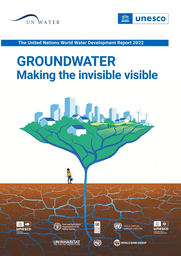World Water Development Report 2022 Dedicated To Groundwater
"Making The Invisible Visible"
3 Apr 2022 by The Water Diplomat
DAKAR, Senegal

The United Nations World Water Development Report 2022 (WWDR 2022), released on 21 March, is entitled ‘groundwater: making the invisible visible’.
Of the freshwater on earth, 79% is locked in solid form in the ice caps of the north and south pole, but of the remaining liquid freshwater, 99% is groundwater. Groundwater, according to the report, has tremendous potential to satisfy social, economic and environmental needs, as well as being a vital resource to increase resilience against climate change.
However, groundwater is also a vulnerable resource, for various reasons. Groundwater recharge rates and flows are insufficiently understood. In many areas, groundwater is being extracted at rates well above the sustainable rate of recharge. Pollution from agriculture, mining, industry, and human settlement is threatening groundwater quality. Legal systems are often not conducive to the protection of the quantity and quality of groundwater.
Groundwater is unevenly spread over the planet. Local dependence on the use of groundwater depends on its availability and accessibility as well as the amount of water demand. Because groundwater is often of high quality, it is extensively used to supply human settlements.
WWDR 2022 estimates that 50% of the global urban population is already supplied from groundwater sources, and this dependence is increasing. Where urban development is rapid and unregulated, private water wells can add to the pressure on local resources, while unplanned sanitation and concentrations of simple on-site systems such as pit latrines can threaten the quality of underground water sources.
Groundwater accounts for only 25% of global water use in agriculture, although in some regions such as North America and Asia, agricultural groundwater use is much more extensive. Agricultural runoff from irrigated fields is often rich in nutrients and pesticides and can pollute surface waters and coastal areas unless well regulated.
Similarly, some industries such as food and beverage industries have high groundwater dependency rates, and the discharge of industrial effluent into the environment can pollute groundwater unless it is effectively treated before release. Mines also frequently require dewatering, and the disposal of this wastewater may hold risks for groundwater sources.
WWDR 2022 emphasises the need to build and update the knowledge base on groundwater, stating that groundwater monitoring is a neglected area. It is not the lack of scientific knowledge but the lack of site-specific data which enables groundwater assessments and scenario development for its use.
Similarly, at a national level, the approach to groundwater is often limited to a focus on extraction rather than integrating groundwater into national water resources management which should be extended to include replenishment, protection, and implementation of measures that aim to preserve groundwater systems and services.
Related Topics
30 Mar 2022 DAKAR, Senegal
A new joint research report by the British Geological Survey and UK-based NGO, Water Aid, has positioned groundwater as a neglected defence against climate change. The researchers ...
13 Feb 2022 KAMPALA, Uganda
IGAD organizes 2nd Water Dialogue Forum on "Groundwater For Resilience"; the axis of groundwater for peace and stability, groundwater for climate change and resilience to drought
Performance Audit Reveals Discrepancies In India’s Groundwater Management Regulations And Implementation
12 Jan 2022 NEW DELHI, India
Groundwater extraction had increased from 58 per cent to 63 per cent between the period of 2004-2017, with a sharp decline in the number of assessment units considered safe. Violat...
